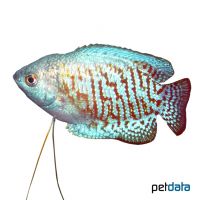Neon Blue Dwarf Gourami (Trichogaster lalius 'Neon Blue')
| Neon Blue Dwarf Gourami Trichogaster lalius 'Neon Blue' | |
|---|---|
| Name | Neon Blue Dwarf Gourami |
| Name Lat. | Trichogaster lalius 'Neon Blue' |
| Synonym | Colisa lalia |
| Family | Gouramies |
| Family lat. | Osphronemidae |
| Order | Labyrinth Fishes |
| Order lat. | Anabantiformes |
| Origin | Southeast Asia |
| Habitat | Ponds, floodplains |
| Diet | Omnivore |
| pH | 6.0-7.5 |
| Behavior | Peaceful |
| Keeping | Pair |
| Care Level | Moderate |
| Reproduction | Bubble nest builder |
| Breeding | Moderately difficult |
| Life Span | 3-4 years |
| Protection | No |
| Metric Units | |
| Size | 5 cm |
| Temperature | 22-27 °C |
| Hardness | 5-15 °dH |
| Aquarium | ~ 50 l |
| US Units | |
| Size | 2" |
| Temperature | 72-81 °F |
| Hardness | 89-267 ppm |
| Aquarium | ~ 15 gal |
Distribution and habitat
Dwarf gourami are common in the Ganges lowlands and the Brahmaputra river system (India), as well as in Nepal and Bangladesh. There they live in waters with dense vegetation, such as ponds, ditches, ponds and lakes, as well as rice fields and floodplains. The Neon Blue Dwarf Gourami is a color form of Trichogaster lalius.
Maintenance
The aquarium should have dense planting with many hiding places (stones, roots). A dark substrate covered with some foliage (sea almond leaves) and subdued light (floating plant cover) is ideal.
No ammonia, ammonium and nitrite should be detectable, the nitrate value should not exceed 100 mg/l. To ensure the water quality and oxygen content, a filter and heater adapted to the aquarium size is required, as well as lighting for the species-appropriate day-night rhythm of the animals.
Diet
They require mainly animal food, supplemented with algae. The food supply consists of live food, such as daphnia, cyclops, tubifex, artemia and mosquito larvae, which are also eaten in frozen form without any problems, plus commercially available, frozen special food mixtures, supplemented with algae leaves and high-quality dry food (flakes, granules) with high vegetable content (e.g. spirulina, kelp)
Only feed as much as is eaten immediately (in a maximum of 10 minutes). A regular and varied diet promotes health and increases resistance.
Behaviour and compatibility
These peaceful and shy fish should be kept in pairs. They can be kept well in a community tank with not too lively and peaceful fish. During the spawning season they defend their territory
Basically, only mutually compatible fish species with similar demands on water conditions and water temperature should be socialized.
Sex dimorphism
The males are more intensely colored.
Reproduction and breeding
The male builds a loose foam nest, often on the underside of large water plant leaves, and also takes care of the brood. The eggs ejected during the numerous matings (entwinements) rise to the water surface, are collected by the male and introduced into the nest. The larvae hatch after 24-36 hours and swim freely after only 2-3 days.
The fry must be fed several times a day with special rearing food (dust food, Artemia nauplii). In a community tank breeding is hardly possible, because the fry are easy prey
Important
They have an additional respiratory organ, the so-called labyrinth (suprabranchial organ) with which they breathe atmospheric air and can suffocate if this is not possible. The air temperature in the breathing area must not be below the water temperature! The thread-like extended ventral fins serve the chemical perception (taste stimuli)
Experience shows that the water temperature should not exceed 28° C over a longer period.
The well-being of the fish should be checked regularly. The temperature should be checked daily, the pH, hardness and nitrate value at least every 14 days. A regular partial water change is recommended, even if the pollutant load has not yet reached the upper limit. Sudden changes in water quality should be avoided. Newly introduced fish must be accustomed slowly to the water in the aquarium
Further literature can be found in your pet store.
References
Text: petdata; Image: petdata
Source: BMELV (1998): Tierschutzgutachten - Haltung von Zierfischen (Süßwasser); RIEHL & BAENSCH (2006): Aquarien Atlas Bd. 1, Mergus Verlag; ENGELMANN (2006): Zootierhaltung - Tiere in menschlicher Obhut: Fische, Verlag Harri Deutsch
- Gemäß § 21 Abs. 5 Tierschutzgesetz idgF
